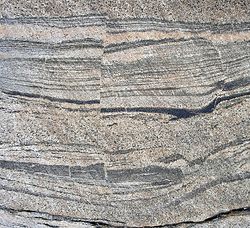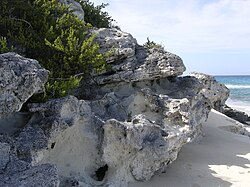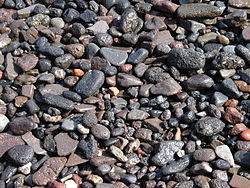Sediments/Sedimentology

Sedimentology is the science and study of sediments.
With appropriate conditions, sediment is transformed into rock. These are the sedimentary rocks.
In the image on the right, blues and grays are a sign of carbon from decaying organic material that was buried or under water and not exposed to air. Reds result from an iron mineral, hematite. When exposed to air, even a small amount of iron causes the rocks to oxidize or rust. The whites represent nearly pure bentonite clay. Ground water, percolating through the buried sediments, also accounts for some color changes.
Theoretical sedimentology
[edit | edit source]
Def. a "study of natural sediments and of the processes by which they are formed"[1] is called sedimentology.
Sediments
[edit | edit source]
Def. a "collection of small particles, particularly dirt, that precipitates from a river or other body of water"[2] is called a sediment.
Intraclasts
[edit | edit source]
Def. a "sediment formed by the redeposition of material erodes from an original deposit"[3] is called an intraclast.
Lithification
[edit | edit source]
Def. the "compaction and cementation of sediment into rock"[4] is called lithification.
Def. a "subdivision of any stratigraphic unit that has characteristic lithologic features"[5] is called a lithofacies.
Def. the "formation of sedimentary rock"[6] is called lithogenesis.
Def. "an element that forms silicates or oxides and is concentrated in the minerals of the Earth's crust"[7] is called a lithophile.
"The rocks [in the image on the right] are quartzose sandstones that were deposited on the eastern shore of ancient Lake Uinta, which existed during the Eocene. Some wisps and ribbons of dark-colored, magnetite-rich sand are present in the sandstone. The variety of chaotic rockforms at Fantasy Canyon are quite diverse - these cannot be explained by ordinary weathering and erosion. Close examination shows that erosion has acted upon differentially cemented sandstone. The sandstone has not undergone complete lithification and diagenesis - groundwater lobes have preferentially cemented portions of the sandstone, especially immediately adjacent to joint planes. The poorly-cemented sandstone was easily eroded & the better-cemented sandstone remains."[8]
Bedrocks
[edit | edit source]
Def. a "solid rock that exists at some depth below the ground surface"[9] is called a bedrock.
"Bedrock is rock "in place", as opposed to material that has been transported from another location by weathering and erosion."[9]
Usage notes
"In mountainous regions, bedrock can be seen at the surface. However, these occurrences are more properly called outcrops."[9]
Regoliths
[edit | edit source]
Def. a "layer of loose rock, dust, sand, and soil, resting on the bedrock, that constitutes the surface layer"[10] is called a regolith.
Saprolites
[edit | edit source]
Def. "a chemically weathered rock "[11] is called a saprolite.
Laterites
[edit | edit source]
Def. a "red hard or gravel-like soil or subsoil [...] that has been leached of soluble minerals leaving insoluble iron and aluminium oxides and hydroxides"[12] is called a laterite.
Drifts
[edit | edit source]Def. a "mass of matter which has been driven or forced onward together in a body, or thrown together in a heap"[13] is called drift.
The image on the right shows morainic drift on the surface north of the surge glacier Brúarjökull in Iceland.
Tills
[edit | edit source]
Def. "glacial drift consisting of a mixture of clay, sand, pebbles and boulders"[14] is called till, or glacial till.
The image on the right shows glacial till exposed in a road cut with some plants growing on top.
Outwashes
[edit | edit source]
Def. a "sediment (mostly sand and gravel) deposited by water flowing from a melting glacier"[15] is called an outwash.
Erratics
[edit | edit source]
Def. a "rock moved from one location to another"[16] is called an erratic.
Landslides
[edit | edit source]
Def. "a movement of surface material down a slope"[17] is called a landslide.
Lahars
[edit | edit source]
Def. a "volcanic mudflow"[18] is called a lahar.
Part of the Mount St. Helens lahar entered Spirit Lake (lower left corner of the image on the right) but most of the flow went west down the Toutle River, eventually reaching the Cowlitz River, 50 miles (80 kilometers) downstream.
Entrainments
[edit | edit source]
Def. any "of several processes in which a solid or liquid is put into motion by a fluid"[19] is called entrainment.
Def. "of, relating to, or situated or occurring at the surface of a glacier"[20] is called supraglacial.
Def. occurring "or located within a glacier"[21] is called englacial.
Def. formed, "or occurring beneath a glacier or other body of ice"[22] is called subglacial.
"Till collected from surface exposures within the valley of the Hudson River south of the Sanford Hill magnetite-ilmenite ore deposit in the Adirondack Mountains of New York is composed primarily of plagioclase, pyroxene, garnet, magnetite, and ilmenite [FeTiO3]. The concentration of magnetite and ilmenite in bulk till both decrease exponentially with increasing distance south of the ore bodies because of dilution by the entrainment of plagioclase and garnet + pyroxene from the bedrock and from older till deposits in the valley. Evidence for comminution of magnetite and ilmenite is provided by decreasing abundances of these minerals in the coarse fractions (1000-125 µm) and corresponding increases in the fine fraction (<125 µm). The apparent rate of comminution of ilmenite as a function of transport distance is significantly greater than that of magnetite, which causes ilmenite to be concentrated in the fine fraction of till compared to magnetite."[23] "The Heiltskuk (also written Ha-Iltzuk) Icefield covers an area of approximately 3,600 square kilometers (1,389 square miles) in the southern Coast Mountains of British Columbia. This detailed astronaut photograph illustrates the icefield—mostly covered by snow across the upper mountain slopes—and two major valley glaciers that extend from it. Valley glaciers are large masses of slowly flowing ice and entrained debris that move downhill, carving out wide U-shaped valleys in the process. The locations of former valley glaciers can frequently be identified by the presence of these U-shaped valleys on a now glacier-free landscape."[24]
"The two largest valley glaciers in the image, Silverthrone Glacier and Klinaklini Glacier, both flow towards Knight Inlet to the south (not shown). Several moraines—accumulations of rock and soil debris along the edges and surface of a glacier—are drawn out into long, dark lines by the flowing ice, and they extend along the length of both glaciers. The confluence of the two glaciers at image center illustrates how a moraine located along the side of a glacier can become a medial moraine, in the center of the joined ice mass. Smaller valley glaciers are visible near Mount Silverthrone""[24]
Diamictons
[edit | edit source]Def. "nonsorted, noncalcareous terrigenous deposits composed of sand and/or larger particles dispersed through a muddy matrix"[25] are called diamictons.
Alluviums
[edit | edit source]Def. "soil, clay, silt or gravel deposited by flowing water, as it slows, in a river bed, delta, estuary or flood plain"[26] is called alluvium.
Loesses
[edit | edit source]
Def. any "sediment, dominated by silt"[27] is called loess.
Def. fine-grained, "silt-size sediment formed by the mechanical erosion of bedrock at the base and sides of a glacier by moving ice"[28] is called rock flour.
"When [rock flour] enters a stream, it turns the stream's color brown, gray, iridescent blue-green, or milky white. [It is also] called Glacier Flour or Glacier Milk."[28]
Soils
[edit | edit source]Def.
- a "mixture of sand and organic material, used to support plant growth",[29]
- an "unconsolidated mineral or organic material on the immediate surface of the earth that serves as a natural medium for the growth of land plants",[29] and
- an "unconsolidated mineral or organic matter on the surface of the earth that has been subjected to and shows effects of genetic and environmental factors of: climate (including water and temperature effects), and macro- and microorganisms, conditioned by relief, acting on parent material over a period of time"[29]
is called a soil.
"The Port series [shown in the profile on the right] consists of very deep, well-drained, moderately permeable, nearly level and very gently sloping soils on flood plains that are subject to frequent, occasional, or rare flooding. These soils are in western and central Oklahoma. They are in 33 of the 77 counties and make up about 1 million acres."[30]
"These soils formed in calcareous, loamy alluvium and under native grasses. A high volume of organic matter recycled in a grass ecosystem has resulted in good soil structure and tilth. Most areas of the soils are used as cropland. The main cultivated crops are alfalfa, wheat, grain sorghum, and cotton. Some areas are used as pasture or rangeland."[30]
Aeolianites
[edit | edit source]
Def. a "rock formed from dune sand, often calcareous"[31] is called an aeolianite.
Turbidites
[edit | edit source]

Def. "sea-bottom deposits formed by massive slope failures where rivers have deposited large deltas"[32] are called turbidites.
"Turbidites [shown in the image on the right] are sea-bottom deposits formed by massive slope failures where rivers have deposited large deltas. These slopes fail in response to earthquake shaking or excessive sedimentation load. The temporal correlation of turbidite occurrence for some deltas of the Pacific Northwest suggests that these deposits have been formed by earthquakes."[32]
"Turbidites (interbedded with mudstones/siltstones) from the Ross Sandstone Formation Turbidite system of Namurian age in County Clare, Western Ireland. The sandstone beds were formed in a deep basin by turbidites coming from a delta area."[32]
Marginal marines
[edit | edit source]
The marginal marine sequence on the right has been dated to the Middle Triassic.
Limestones
[edit | edit source]
The middle Triassic layers of alpine limestone in the image on the right were deposited on the bottom of a shallow sea.
Layered sediments
[edit | edit source]Def. secondary "rings or bands resulting from rhythmic precipitation in a gel, or within a fluid-saturated rock"[33] are called Liesegang rings.
"The ruin marble structure of the Cretaceous/Paleogene fine-grained marly limestone from the Outer Flysch Belt of the Western Carpathians has a non-tectonic origin, according to structural and sedimentological evidence. Distinctive offsets of coloured red-brownish ferric oxyhydroxide bands are not due to displacements along rock-cutting fractures, as they superficially appear to be. Evidences for shear movement along these pseudo-faults were not observed. Band offsets result from different velocities of pervasively diffusing fluids, precipitating ferric oxyhydroxides in corridors bounded by sets of mineralised systematic joints. During rock weathering, calcite-filled joints operated as barriers for lateral fluid diffusion, but enabled longitudinal diffusion along healed joints."[34]
Diameters
[edit | edit source]
Def. a "particle classification system ... based on diameter"[35] is called the Wentworth scale.
Boulders
[edit | edit source]
Def. "[a] particle [or large piece of stone] greater than 256 mm in diameter [that can theoretically be moved if enough force is applied]"[36] is called a boulder.
Cobbles
[edit | edit source]
Def. "[a] particle from 64 to 256 mm in diameter"[37] is called a cobble.
Pebbles
[edit | edit source]
Def.' "[a] particle from 4 to 64 mm in diameter"[38] is called a pebble.
Granules
[edit | edit source]Def. "[a] particle from 2 to 4 mm in diameter"[39] is called a granule.
Gravels
[edit | edit source]
Def. "[a] particle from 2 to 64 mm in diameter"[40] is called a gravel.
Sands
[edit | edit source]
Def. "[a] particle from 62.5 microns to 2 mm in diameter"[41] is called a sand.
Muds
[edit | edit source]
Def. "[a] particle less than 62.5 microns in diameter"[42] is called a mud.
Silts
[edit | edit source]
Def. a "particle from 3.9 to 62.5 microns in diameter"[43] is called silt.
Clays
[edit | edit source]
Def. a "particle less than 3.9 microns in diameter"[44] is called clay.
Colloids
[edit | edit source]
Def. "[a] particle less than 1 micron in diameter"[45] is called a colloid.
Technology
[edit | edit source]
A sediment core sample extracted for the ANtarctic geological DRILLing program known as ANDRILL is shown on the right. Sediment and rock core were extracted from the ocean floor under the Ross Ice Shelf during the 2006-2007 austral summer.
Hypotheses
[edit | edit source]- Sedimentology like other sciences begins with common elements such as sediments.
See also
[edit | edit source]References
[edit | edit source]- ↑ SemperBlotto (18 August 2006). "sedimentology, In: Wiktionary". San Francisco, California: Wikimedia Foundation, Inc. Retrieved 2014-11-09.
{{cite web}}:|author=has generic name (help) - ↑ "sediment, In: Wiktionary". San Francisco, California: Wikimedia Foundation, Inc. 29 October 2014. Retrieved 2014-12-05.
- ↑ "intraclast, In: Wiktionary". San Francisco, California: Wikimedia Foundation, Inc. 21 June 2013. Retrieved 2015-02-15.
- ↑ "lithification, In: Wiktionary". San Francisco, California: Wikimedia Foundation, Inc. 17 August 2013. Retrieved 2015-02-19.
- ↑ "lithofacies, In: Wiktionary". San Francisco, California: Wikimedia Foundation, Inc. 27 May 2014. Retrieved 2015-02-19.
- ↑ "lithogenesis, In: Wiktionary". San Francisco, California: Wikimedia Foundation, Inc. 26 May 2014. Retrieved 2015-02-19.
- ↑ "lithophile, In: Wiktionary". San Francisco, California: Wikimedia Foundation, Inc. 2 April 2014. Retrieved 2015-02-19.
- ↑ James St. John (10 June 2012). "Fantasy Canyon". Flickr. Retrieved 2017-01-25.
- ↑ 9.0 9.1 9.2 "bedrock, In: Wiktionary". San Francisco, California: Wikimedia Foundation, Inc. 7 July 2014. Retrieved 2014-12-05.
- ↑ "regolith, In: Wiktionary". San Francisco, California: Wikimedia Foundation, Inc. 25 May 2014. Retrieved 2014-12-05.
- ↑ "Saprolite, In: Wikipedia". San Francisco, California: Wikimedia Foundation, Inc. 12 April 2014. Retrieved 2014-12-05.
- ↑ "laterite, In: Wiktionary". San Francisco, California: Wikimedia Foundation, Inc. 24 May 2014. Retrieved 2014-12-05.
- ↑ "drift, In: Wiktionary". San Francisco, California: Wikimedia Foundation, Inc. 18 October 2014. Retrieved 2014-12-03.
- ↑ "till, In: Wiktionary". San Francisco, California: Wikimedia Foundation, Inc. 17 November 2014. Retrieved 2014-12-04.
- ↑ "outwash, In: Wiktionary". San Francisco, California: Wikimedia Foundation, Inc. 17 April 2014. Retrieved 2014-12-05.
- ↑ "erratic, In: Wiktionary". San Francisco, California: Wikimedia Foundation, Inc. 13 August 2014. Retrieved 2014-12-05.
- ↑ USGS (July 18, 2012). "Earthquake Glossary - landslide". Menlo Park, California USA: USGS. Retrieved 2014-12-02.
- ↑ "lahar, In: Wiktionary". San Francisco, California: Wikimedia Foundation, Inc. 16 December 2014. Retrieved 2015-02-17.
- ↑ "entrainment, In: Wiktionary". San Francisco, California: Wikimedia Foundation, Inc. 7 November 2013. Retrieved 2014-11-22.
- ↑ "supraglacial, In: Wiktionary". San Francisco, California: Wikimedia Foundation, Inc. 26 May 2014. Retrieved 2014-11-22.
- ↑ "englacial, In: Wiktionary". San Francisco, California: Wikimedia Foundation, Inc. 20 April 2011. Retrieved 2014-11-22.
- ↑ "subglacial, In: Wiktionary". San Francisco, California: Wikimedia Foundation, Inc. 1 February 2011. Retrieved 2014-11-22.
- ↑ Kent S. Whiting and Gunter Faure (May 1991). "Transport of Magnetite and Ilmenite by Glaciers in the Adirondack Mountains of New York". The Journal of Geology 99 (3): 482-92. http://www.jstor.org/discover/10.2307/30062630?uid=3739552&uid=2&uid=4&uid=3739256&sid=21104257622971. Retrieved 2014-10-01.
- ↑ 24.0 24.1 William L. Stefanov (31 August 2009). "Heiltskuk Icefield, British Columbia". Washington,DC USA: NASA. Retrieved 2014-11-14.
- ↑ L. J. G. Schermerhorn (September 1966). "Terminology of Mixed Coarse-Fine Sediments: NOTES". Journal of Sedimentary Petrology 36 (3): 831-5. http://archives.datapages.com/data/sepm/journals/v33-37/data/036/036003/0831.htm. Retrieved 2014-11-08.
- ↑ SemperBlotto (12 August 2005). "alluvium, In: Wiktionary". San Francisco, California: Wikimedia Foundation, Inc. Retrieved 2014-11-10.
{{cite web}}:|author=has generic name (help) - ↑ SemperBlotto (31 March 2006). "loess, In: Wiktionary". San Francisco, California: Wikimedia Foundation, Inc. Retrieved 2014-11-10.
{{cite web}}:|author=has generic name (help) - ↑ 28.0 28.1 Eleyne Phillips (16 December 2004). "Glossary of Glacier Terminology". Reston, Virginia USA: United States Geological Survey. Retrieved 2014-11-09.
- ↑ 29.0 29.1 29.2 "soil, In: Wiktionary". San Francisco, California: Wikimedia Foundation, Inc. 25 November 2014. Retrieved 2014-12-05.
- ↑ 30.0 30.1 Natural Resources Conservation Service (5 December 2014). Port -- Oklahoma State Soil. Washington, DC USA: U. S. Department of Agriculture. http://www.nrcs.usda.gov/wps/PA_NRCSConsumption/download?cid=stelprdb1236986&ext=pdf. Retrieved 2014-12-05.
- ↑ "aeolianite, In: Wiktionary". San Francisco, California: Wikimedia Foundation, Inc. 28 May 2014. Retrieved 2014-12-06.
- ↑ 32.0 32.1 32.2 USGSTurbidites (July 24, 2012). "Earthquake Glossary - turbidites". Menlo Park, California USA: USGS. Retrieved 2014-12-02.
- ↑ "Liesegang rings, In: Wiktionary". San Francisco, California: Wikimedia Foundation, Inc. 19 June 2013. Retrieved 2015-02-21.
- ↑ František Marko, Daniel Pivko and Vratislav Hurai (2003). "Ruin marble: a record of fracture-controlled fluid flow and precipitation". Geological Quarterly 47 (3): 241-52. https://gq.pgi.gov.pl/article/download/7313/5963. Retrieved 2015-02-21.
- ↑ "Wentworth scale, In: Wiktionary". San Francisco, California: Wikimedia Foundation, Inc. September 13, 2012. Retrieved 2012-10-23.
- ↑ "boulder, In: Wiktionary". San Francisco, California: Wikimedia Foundation, Inc. September 21, 2012. Retrieved 2012-10-23.
- ↑ "cobble, In: Wiktionary". San Francisco, California: Wikimedia Foundation, Inc. September 1, 2012. Retrieved 2012-10-23.
- ↑ "pebble, In: Wiktionary". San Francisco, California: Wikimedia Foundation, Inc. October 16, 2012. Retrieved 2012-10-23.
- ↑ "granule, In: Wiktionary". San Francisco, California: Wikimedia Foundation, Inc. October 16, 2012. Retrieved 2012-10-23.
- ↑ "gravel, In: Wiktionary". San Francisco, California: Wikimedia Foundation, Inc. October 16, 2012. Retrieved 2012-10-23.
- ↑ "sand, In: Wiktionary". San Francisco, California: Wikimedia Foundation, Inc. October 23, 2012. Retrieved 2012-10-23.
- ↑ "mud, In: Wiktionary". San Francisco, California: Wikimedia Foundation, Inc. October 23, 2012. Retrieved 2012-10-23.
- ↑ Metaknowledge (31 March 2006). "silt, In: Wiktionary". San Francisco, California: Wikimedia Foundation, Inc. Retrieved 2014-11-10.
{{cite web}}:|author=has generic name (help) - ↑ Metaknowledge (17 March 2012). "clay, In: Wiktionary". San Francisco, California: Wikimedia Foundation, Inc. Retrieved 2014-11-10.
{{cite web}}:|author=has generic name (help) - ↑ "colloid, In: Wiktionary". San Francisco, California: Wikimedia Foundation, Inc. September 8, 2012. Retrieved 2012-10-23.
